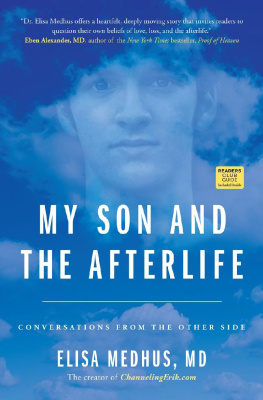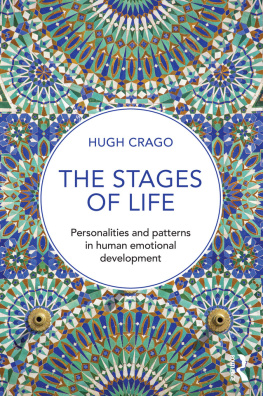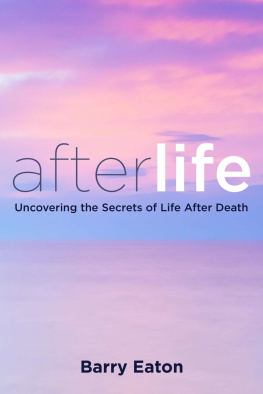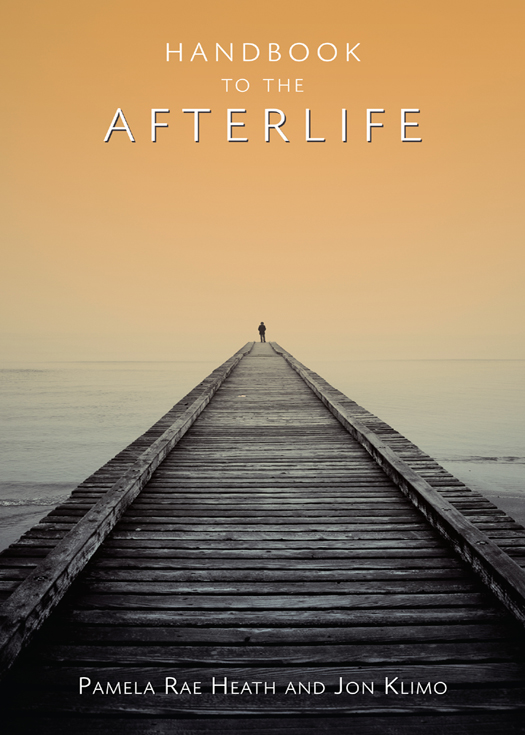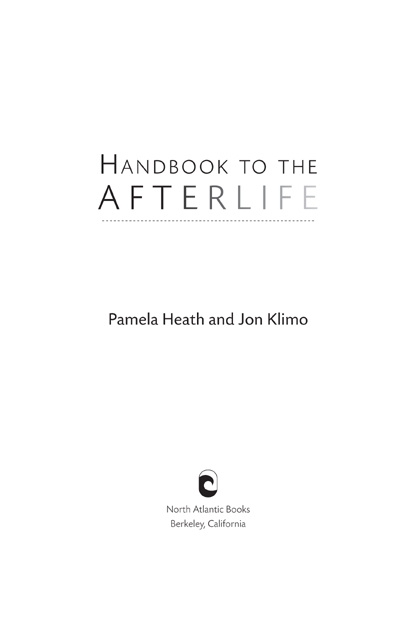A LSO BY P AMELA H EATH AND J ON K LIMO
Suicide: What Really Happens in the Afterlife?
eISBN: 978-1-58394-427-1
Copyright 2010 by Pamela Heath and Jon Klimo. All rights reserved. No portion of this book, except for brief review, may be reproduced, stored in a retrieval system, or transmitted in any form or by any meanselectronic, mechanical, photocopying, recording, or otherwisewithout the written permission of the publisher. For information contact North Atlantic Books.
Published by
North Atlantic Books
P.O. Box 12327
Berkeley, California 94712 | Cover istockphoto.com/profeta
Cover and book design by Susan Quasha |
Handbook to the Afterlife is sponsored by the Society for the Study of Native Arts and Sciences, a nonprofit educational corporation whose goals are to develop an educational and cross-cultural perspective linking various scientific, social, and artistic fields; to nurture a holistic view of arts, sciences, humanities, and healing; and to publish and distribute literature on the relationship of mind, body, and nature.
Library of Congress Cataloging-in-Publication Data
Heath, Pamela Rae.
Handbook to the afterlife / Pamela Heath and Jon Klimo.
p. cm.
Includes bibliographical references.
1. Future life. 2. Spiritualism. I. Klimo, Jon. II. Title.
BF1311.F8H42 2010
133.9013dc22
2009046980
v3.1
This book is dedicated to
our loved ones in the afterlife.
Acknowledgments
The authors wish to acknowledge the many mediums who channeled the material summarized in this book. We also wish to thank Deanne Knowland, Johanna Carroll, Lauren Thibodeau, and our publisher, North Atlantic Books, for their contributions and ongoing support.
Abbreviations
| ASC: | Altered State of Consciousness |
| DVP: | Direct Voice Phenomena |
| EVP: | Electronic Voice Phenomena |
| ITC: | Instrumental Transcommunication |
| MMI: | Mind-Matter Interaction |
| NDE: | Near-Death Experience |
| OBE: | Out-of-Body Experience |
Contents
PART I
Views on the Afterlife
CHAPTER 1
About This Book
T HIS BOOK PRIMARILY USES INFORMATION from channeled or mediumistically conveyed sources to talk about the kind of experiences human spirits are said to have as they transition through the process of death and move into the so-called afterlife. From this, we, the still physically living, can gain insight about what may await us once we die. Some of the information about this process is drawn from our earlier book, Suicide: What Really Happens in the Afterlife? and Klimos book Channeling: Receiving Information from Paranormal Sources. This handbook, however, will focus only on the reported nature of the afterlife experience without focusing on the manner of death that led to that afterlife.
Keeping the Book Simple
Throughout this book, we have purposefully avoided making this the much more scholarly work it could have been, filled with citations, references, and quotations from a great many resources. Because we want this book to be a very accessible, non-taxing introduction, primer, or handbook about the afterlife, we have chosen to leave the traditional scholarly process aside for the most part and simply list at the end of our book selected published sources available to you from which we have drawn. Our book is inductive in nature; that is, we have drawn upon a great many sources and are providing you with the common content, categories, and recurrent themes that have kept emerging for us from all this material.
As you go through Part Two of this book, know that at every turn, with every chapter title, what you are reading are the generalizations, patterns, and themes that have arisen from many hundreds of books we have studied, and from a number of mediumistic sances we conducted (primarily Heath). For a good example of a more traditional scholarly approach, which constantly refers to and draws from specific published sources and sances conducted, you are welcome to read our earlier book, Suicide: What Really Happens in the Afterlife? You can also look at the references section at the end of this book, as well as the sources listed in the endnotes, to trace what we say throughout this book back to the published material from which it comes.
How This Book Differs from Others
You might ask what makes this book different from all the others on the afterlife that are already available in print. It is simply this: most books present only the viewpoint of a single medium or channel, or of a single channeled or mediumistically conveyed source. Our handbook is much broader, not being limited to any one source or time, and includes information from other than channeled/mediumistic sources, drawing from over two hundred years of published material from throughout the world.
This information is said to come from many different sources, including 1) from human, and sometimes nonhuman, discarnate (nonphysical) spirits; 2) from interviews with various survival researchers, psychics, mediums, and channels, and from sances (to use a term carried over from the nineteenth century) that we, the authors, have conducted; and 3) from sources other than through mediumship and channeling, including mystic/visionary experiences, out-of-body experiences (OBEs), near-death experiences (NDEs), past-life and reincarnation reports, psi or psychic means (such as clairvoyance and remote viewing), and, to a lesser extent, from dreams and lucid dreams, and from experiences obtained through altered states of consciousness (ASCs).
Not Trying to Prove or Convince
As with our last book, Suicide: What Really Happens in the Afterlife?, our purpose is not to provide evidence that we survive physical death and are able to communicate back to the physically living. Attempts to find irrefutable evidence either completely for or against the survival hypothesis are still indecisive and ongoing. Nor is it our purpose to try to make a case that mediumship/channeling actually involves mediating spirit communication from beings residing in an afterlife domain, rather than involving some kind of self-generated, dissociated brain-mind activity of the medium or channel, or, worse, being a function of intentional fraud or hoaxing. Again, attempts to completely prove or disprove the reality of mediumship or channeling are still in progress, and any ultimate resolution of the matter remains elusive. Rather, we choose to summarize the published, and sance-derived, material purported to originate from informants on the other side of physical death and let you make of it what you will.
The books content draws heavily from mediumistic/channeled information and messages. In our research and writing, we were faced throughout with a choice about how to present and refer to this kind of mediumistic material, to the sources from which it reportedly comes, to the reality of the process itself, and to the reality of survival of physical death and the presence of an afterlife. However, we decided that it is too cumbersome to use a style that constantly couches and qualifies every reference to each channeled source, to the nature of the channeled process, and to the notion of survival of death and of an afterlife, by over and over using conservative adjectives and defensive phrases, such as supposed, reported, purported, reputed, ostensible, alleged, so-called, hypothesized, said to be, and so on. Such a practice can be distracting to the reading process. So, for ease of reading, and to avoid tedious repetition, we have chosen to present things as clearly and simply as we can, with as little self-editorializing as possible.






